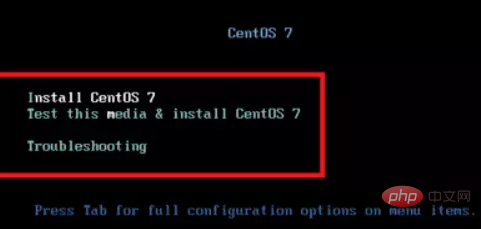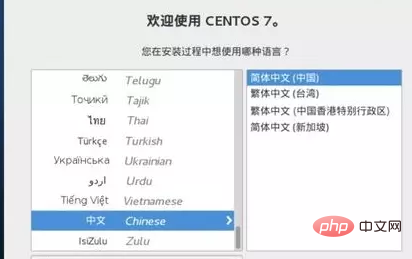 Operation and Maintenance
Operation and Maintenance
 Linux Operation and Maintenance
Linux Operation and Maintenance
 How to install linux system using USB disk
How to install linux system using USB disk

1. Preparation work
1. Disk larger than 8GU
2. UltraSo floppy disk pass
3. CentOS 7.4 ISO image
2. Making a Linux boot disk
It is recommended to use ultraSo floppy disk pass to write the disk image
1. Install UltraISO
2. After the installation is completed, click [Trial]
3. Click [File] and select [Open]
4. Find the file where the Centos7 package is located folder, select the Centos7 package, click [Open]
5. Insert the prepared U disk
6. Click [Start] in the top menu and select [Write Hard Disk Image]
Online video tutorial sharing: linux video tutorial
ps: Note that it is a hard disk, not a floppy disk
7. Select your U for the hard drive disk, writing method usb hdd
8. Click [Write]
3. Install the system
#1. Insert the U disk into the computer Up
2. Start the computer and keep pressing [F2] to enter the BIOS to modify the first startup item
3. Select the U disk and jump to the interface below

4. Press the keyboard key to enter the second Test this media & install Centos 7, and change the bottom
vmlinuz initrd=initrd.img inst.stage2=hd:LABEL=CentOS\x207\x20x86_64 rd.live.check quiet changed to
inst.stage2=hd:/dev/sdb4 (your own USB disk (symbol) quiet Ctrl ##vmlinuz initrd=initrd.img linux dd quiet
5, and then wait for the installation to the graphical interface
7. Installation source: local media; software selection: GNOME desktop (if the default is not visible, The desktop is just a command line, and the minimum installation is selected); installation location: select your hard disk, automatically allocated (the one with the largest memory can also be allocated by yourself); network and host name: open (closed by default) 
linux tutorial
The above is the detailed content of How to install linux system using USB disk. For more information, please follow other related articles on the PHP Chinese website!

Hot AI Tools

Undress AI Tool
Undress images for free

Undresser.AI Undress
AI-powered app for creating realistic nude photos

AI Clothes Remover
Online AI tool for removing clothes from photos.

Clothoff.io
AI clothes remover

Video Face Swap
Swap faces in any video effortlessly with our completely free AI face swap tool!

Hot Article

Hot Tools

Notepad++7.3.1
Easy-to-use and free code editor

SublimeText3 Chinese version
Chinese version, very easy to use

Zend Studio 13.0.1
Powerful PHP integrated development environment

Dreamweaver CS6
Visual web development tools

SublimeText3 Mac version
God-level code editing software (SublimeText3)
 Using Task Manager in Linux
Aug 15, 2024 am 07:30 AM
Using Task Manager in Linux
Aug 15, 2024 am 07:30 AM
There are many questions that Linux beginners often ask, "Does Linux have a Task Manager?", "How to open the Task Manager on Linux?" Users from Windows know that the Task Manager is very useful. You can open the Task Manager by pressing Ctrl+Alt+Del in Windows. This task manager shows you all the running processes and the memory they consume, and you can select and kill a process from the task manager program. When you first use Linux, you will also look for something that is equivalent to a task manager in Linux. A Linux expert prefers to use the command line to find processes, memory consumption, etc., but you don't have to
 7 ways to help you check the registration date of Linux users
Aug 24, 2024 am 07:31 AM
7 ways to help you check the registration date of Linux users
Aug 24, 2024 am 07:31 AM
Did you know, how to check the creation date of an account on a Linux system? If you know, what can you do? Did you succeed? If yes, how to do it? Basically Linux systems don't track this information, so what are the alternative ways to get this information? You may ask why am I checking this? Yes, there are situations where you may need to review this information and it will be helpful to you at that time. You can use the following 7 methods to verify. Use /var/log/secure Use aureport tool Use .bash_logout Use chage command Use useradd command Use passwd command Use last command Method 1: Use /var/l
 How to hide your Linux command line history
Aug 17, 2024 am 07:34 AM
How to hide your Linux command line history
Aug 17, 2024 am 07:34 AM
If you are a Linux command line user, sometimes you may not want certain commands to be recorded in your command line history. There could be many reasons, for example, you hold a certain position in a company and you have certain privileges that you don't want others to abuse. Or maybe there are some particularly important commands that you don't want to execute by mistake while browsing the history list. However, is there a way to control which commands go into the history list and which don't? Or in other words, can we enable incognito mode like a browser in a Linux terminal? The answer is yes, and depending on the specific goals you want, there are many ways to achieve it. In this article, we’ll discuss some proven methods. Note: All commands appearing in this article have been tested under Ubuntu. different
 Compare and sync files in Ubuntu with FreeFileSync
Aug 19, 2024 pm 07:39 PM
Compare and sync files in Ubuntu with FreeFileSync
Aug 19, 2024 pm 07:39 PM
FreeFileSync is a free, open source, and cross-platform folder comparison and synchronization software that can help you synchronize files and folders in Linux, Windows, and MacOS. It is portable and can be installed on a local system, is feature-rich and is designed to save time setting up and performing backup operations, while having an attractive graphical interface. FreeFileSync Features Here are its main features: It can synchronize network shares and local disks. It can synchronize MTP devices (Android, iPhone, tablets, digital cameras). It can also be synced via SFTP (SSH File Transfer Protocol). It can identify moved and renamed files and files
 Zabbix 3.4 Source code compilation installation
Sep 04, 2024 am 07:32 AM
Zabbix 3.4 Source code compilation installation
Sep 04, 2024 am 07:32 AM
1. Installation environment (Hyper-V virtual machine): $hostnamectlStatichostname:localhost.localdomainIconname:computer-vmChassis:vmMachineID:renwoles1d8743989a40cb81db696400BootID:renwoles272f4aa59935dcdd0d456501Virtualization:microsoftOperatingSystem:CentOS Linux7(Core)CPEOSName:cpe:
 Detailed explanation: Shell script variable judgment parameter command
Sep 02, 2024 pm 03:25 PM
Detailed explanation: Shell script variable judgment parameter command
Sep 02, 2024 pm 03:25 PM
The system variable $n is the parameter passed to the script or function. n is a number indicating the number of parameters. For example, the first parameter is $1, and the second parameter is $2$? The exit status of the previous command, or the return value of the function. Returns 0 on success, 1 on failure $#Number of parameters passed to the script or function $* All these parameters are enclosed in double quotes. If a script receives two parameters, $* is equal to $1$2$0The name of the command being executed. For shell scripts, this is the path to the activated command. When $@ is enclosed in double quotes (""), it is slightly different from $*. If a script receives two parameters, $@ is equivalent to $1$2$$the process number of the current shell. For a shell script, this is the process I when it is executing
 Linux Operations: File System, Processes, and More
May 05, 2025 am 12:16 AM
Linux Operations: File System, Processes, and More
May 05, 2025 am 12:16 AM
The core operations of Linux file system and process management include file system management and process control. 1) File system operations include creating, deleting, copying and moving files or directories, using commands such as mkdir, rmdir, cp and mv. 2) Process management involves starting, monitoring and killing processes, using commands such as ./my_script.sh&, top and kill.
 Getting Started: Installing Notepad for Beginners
Apr 29, 2025 am 12:25 AM
Getting Started: Installing Notepad for Beginners
Apr 29, 2025 am 12:25 AM
The steps for installing and initial use of Notepad are as follows: 1) Visit notepad-plus-plus.org to download the appropriate version; 2) Double-click the installation file and install it as prompts; 3) Start Notepad, create a new file and enter text; 4) Save the file and select the file type; 5) Write and run a simple Python program, such as print("Hello,Notepad !"). Through these steps, you can start programming with Notepad smoothly.





